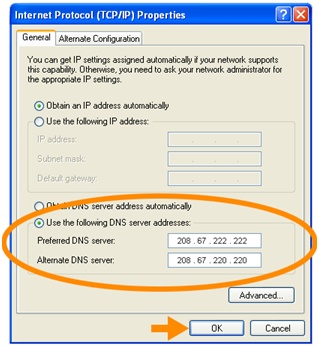Protecting the network through web content filtering
TipsMake.com - In this tutorial we will show you some network data filtering options to protect your home or small business networks by blocking content only for adults or users. try to fake as well as other dangerous sites.

More and more Wi-Fi devices like smartphones, iPods, tablets, gaming devices, etc., make filtering web content for all computers and devices even more difficult. However, instead of installing web content filtering software on each computer and trying to find filtering features for each mobile device, you can implement the solution for the entire network. The solution here can allow filtering at the network level, working with all devices, including mobile devices that do not have content filtering capabilities themselves.
In this tutorial we will show you some network data filtering options to protect small or home networks by blocking adult-only content, or fake attempts. as well as other dangerous sites. Then we will introduce in detail for a specific solution.
Network data filtering options
There are four main ways of filtering wide area network data:
First , most routers have built-in website filtering feature. However, this feature is only useful if you want to block or allow specific sites. For example, it will not block all adult sites.
Second , some routers offer a real content filtering solution, which allows you to block sites based on categories. This method protects the network quite well but requires registration and payment for the service. These solutions target small home and office networks.
Note: To see if your router has a solution to filter websites or filter content, check the router's documentation, detailed product information on the network or log into its administration interface.
Third , there are many DNS-based web content filtering solutions and do not require any additional software or hardware on the network. DNS is used in the background in all networks to support web browsing. To use a DNS-based filtering solution, you need to change the DNS server addresses on your router. This solution can be used in homes and businesses.
The only drawback to a DNS-based solution is that users with a bit of expertise can bypass it by setting up another DNS address on their computer or mobile device. However, this vulnerability can be fixed. Most routers have port filtering or blocking features. We can use it to prevent users from accessing port 53 to all IP addresses except the IP address of the DNS filtering solution. Thus users will not be able to use any other DNS server and must use the DNS server you have configured to set up content filtering.
Fourth , it is possible to filter using hardware filtering devices, which sometimes provide additional services such as firewall, anti-spam and anti-virus. You can buy and install a hardware, this option is often popular in larger organizations. Small businesses can create their own hardware.
Use OpenDNS to filter content
We will show you how to set up a DNS-based solution from OpenDNS. This is a company that provides free services, very suitable for home and small business networks. Although they will encounter ads, they will not appear often and cause discomfort. Setting up the service will include tasks such as creating an account, configuring the router, and then logging into the OpenDNS Dashboard to set up filtering and security functions.
OpenDNS allows web content filtering on 50 different categories, allowing filtering and blocking of specific sites, providing protection against forgery and botnets. In addition to content filtering and security, OpenDNS has a few other advanced features compared to the traditional DNS services provided by ISPs such as SmartCache, shortcuts and print error correction.
To set up, create an OpenDNS account. In this process, step 2 will help you change DNS settings. Select the Router option, which is the option that will help you configure the router image with DNS addresses: 208.67.222.222 and 208.67.220.220 . Note that you need to clear the DNS resolver cache (DNS resolver) and browser cache after configuring the router.

Note: If you have changed the default password for the router and can't remember it, you can set the router to default values by pressing and holding the reset button behind the router for a few seconds to 20 seconds. After that, you need to reconfigure your wireless and security settings.
Next, click on the link below the router configuration page to continue. Your settings will be tested and if successful, you will be taken to the Dashboard screen.
The Dashboard will display the Settings page, prompting you to add a network. Click the Add This Network button. When prompted, name and decide whether to use dynamic IP or not. If you are using dynamic IP for Internet connection, you can download the upgrade software. However, if the computer is not turned on and running continuously, you should configure the router to perform an IP upgrade after configuring OpenDNS Network and settings.
When the Network is successfully added , select the Settings page again. You will see your network here; Click on its IP address to edit all network settings.
If you have a dynamic IP address and you also want to update OpenDNS with this dynamic IP (instead of your computer's IP address), start by configuring your DNS-O-Matic account. This account will automatically be created when you register for OpenDNS and use the same username and password. When logging in, select the service that is OpenDNS, select the desired network (if there are multiple networks), then click Update Account Info . You must now log into the router's console by entering its IP address into the browser, just like when configuring DNS addresses. Then find the Dynamic DNS settings and enter them:
- Server: updates.opendns.com
- Host Name: DNS-O-Matic Network Label
- Username: Your OpenDNS username
- Password: Your OpenDNS passsword
Conclude
In this article, I have shown you some ways to perform web content filtering in the entire network. One thing to remember though, is that there is no perfect way. One method, no matter how safe, has a vulnerability that users can take advantage of. The most popular method and affect almost all solutions is using a VPN or a proxy site or service. Although most solutions can block users from downloading or using these types of sites and services, users can still use their software on USB.
Always included with the content filtering feature to make it even more secure, you should use the Parental Controls feature of Windows Vista and 7 to further control computer usage.
You should read it
- Routing and filtering network traffic - Part 3: Network Address Translation
- What is Deep Packet Inspection (DPI)? How does it work and how does it work in network security?
- Three simple and economical ways for network protection
- Routing and filtering network traffic - Part 1
- Secure WiFi in enterprise environment from basic steps
- Install and configure email handling solutions on TMG 2010 Firewall - Part 4
- Use Group Policy Filtering to create a NAP DHCP enforcement policy - Part 1
- Routing and filtering network traffic - Part 2: Windows Firewall
May be interested
- Why is Gmail filtering good spam?
 most people who have used many different email services have confirmed that gmail has a fast, smooth and compact interface, especially spam filtering very well. so why does gmail have such good email filtering capabilities? recently google revealed a part of the technology it is applying.
most people who have used many different email services have confirmed that gmail has a fast, smooth and compact interface, especially spam filtering very well. so why does gmail have such good email filtering capabilities? recently google revealed a part of the technology it is applying. - Install and configure email handling solutions on TMG 2010 Firewall - Part 5
 in part 5 of this series, i will show you how to configure the edge subscription feature on the tmg 2010 firewall.
in part 5 of this series, i will show you how to configure the edge subscription feature on the tmg 2010 firewall. - How to fix 'Your Wi-Fi Network Isn't Secure' error on Windows
 nowadays, almost everyone knows that protecting network passwords is extremely important. passwords are not the only protection your network needs. it also needs strong encryption so no one can intercept the data.
nowadays, almost everyone knows that protecting network passwords is extremely important. passwords are not the only protection your network needs. it also needs strong encryption so no one can intercept the data. - Use Group Policy Filtering to create a NAP DHCP enforcement policy - Part 1
 how to use group policy to control the implementation of dhcp network access policies, improves the level of performance so that dhcp can be enforced on nap clients.
how to use group policy to control the implementation of dhcp network access policies, improves the level of performance so that dhcp can be enforced on nap clients. - Special content tools and formats on Lotus, helping users create the best content
 the following article will help you get an initial understanding of a range of powerful content formats that will appear on this social network.
the following article will help you get an initial understanding of a range of powerful content formats that will appear on this social network. - Facebook introduces a tool to help women resist personal image theft
 facebook is upgrading some features of protecting user avatars that make them safer, they have begun to be deployed in india. let's find out more details about this feature
facebook is upgrading some features of protecting user avatars that make them safer, they have begun to be deployed in india. let's find out more details about this feature - Use Group Policy Filtering to create a DHCP enforcement policy for NAP - Part 3
 in this part 3, i will show you more about policies and see what they do in a dhcp enforcement solution.
in this part 3, i will show you more about policies and see what they do in a dhcp enforcement solution. - MS Access 2003 - Lesson 19: Filtering data
 a filter allows you to limit the records to view. filtering data does not lose records, it only allows to determine which records you want access to display.
a filter allows you to limit the records to view. filtering data does not lose records, it only allows to determine which records you want access to display. - Spammers are getting ... smarter
 experts say spammers are turning to the trend of using images to replace documents to bypass spam filtering tools.
experts say spammers are turning to the trend of using images to replace documents to bypass spam filtering tools. - Google adds spam protection for Google Messages
 recently google has launched spam filtering for the google messages messaging application to combat spam messages, ads that annoy users.
recently google has launched spam filtering for the google messages messaging application to combat spam messages, ads that annoy users.










 Online security: how to block Google Ads and adjust privacy settings
Online security: how to block Google Ads and adjust privacy settings Computer management with Windows Intune - Part 2: Prepare the environment
Computer management with Windows Intune - Part 2: Prepare the environment Managing computers with Windows Intune - Part 3: Managing computers and upgrading
Managing computers with Windows Intune - Part 3: Managing computers and upgrading Change Kaspersky Security Suite CBE 11 interface from German to English
Change Kaspersky Security Suite CBE 11 interface from German to English Eliminate autorun virus hidden in USB drive
Eliminate autorun virus hidden in USB drive Improve the security of Facebook with SSL encryption protocol
Improve the security of Facebook with SSL encryption protocol